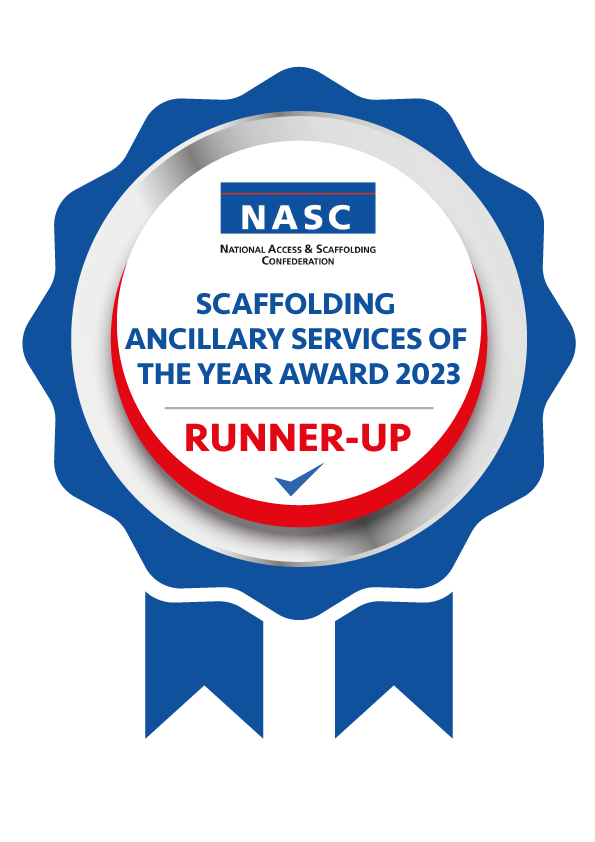-
Overview of Material Hire Rates
In this documentation, we will guide you through setting up pricing for your material depreciation & hire rates in SMART Estimator. Once we’re finished, your Depreciation Rates & Cost Breakdown will be priced accurately and competitively. Ensuring the Contract and Extra Hire per week are automatically calculated to generate an accurate quotation.
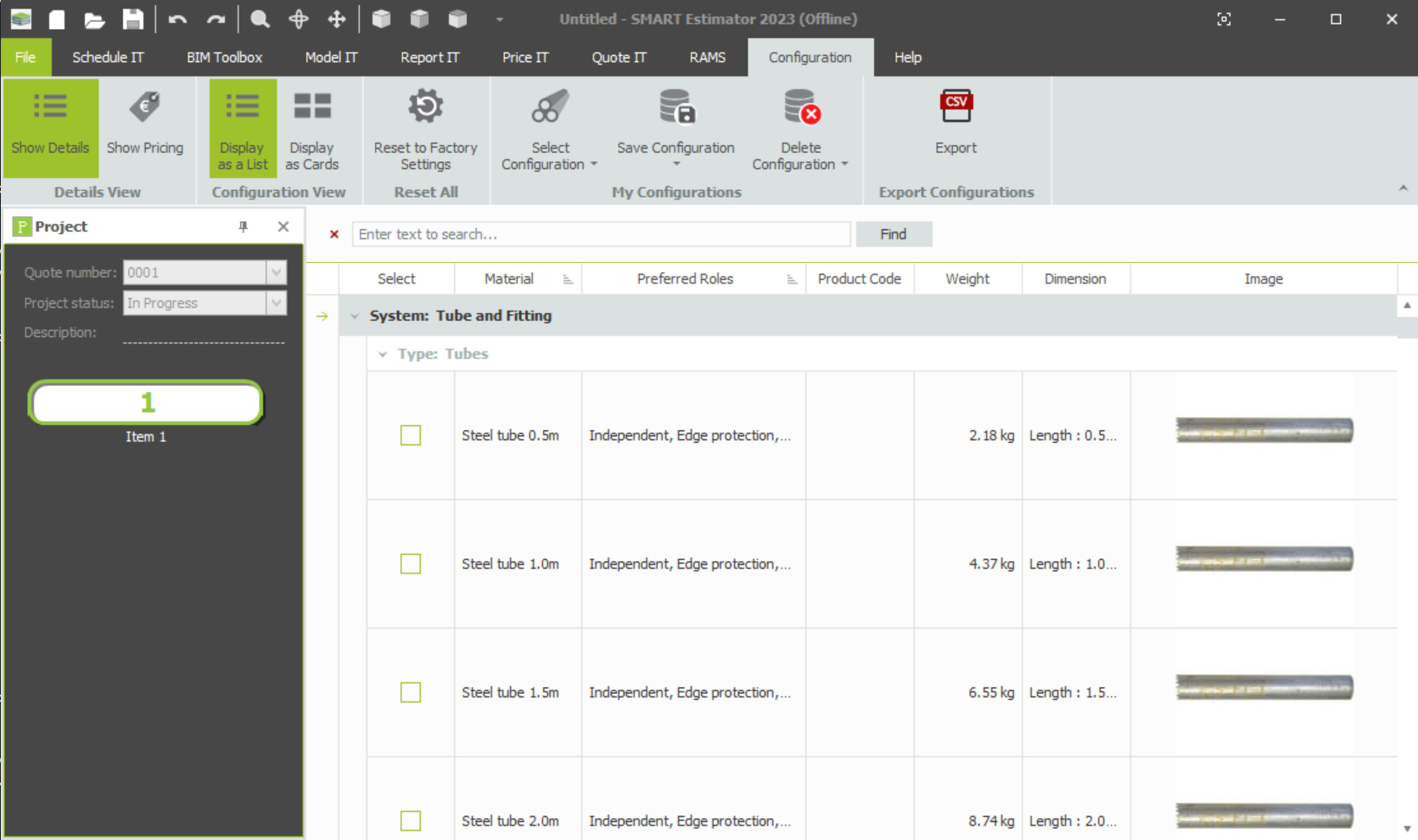
We’ll be covering how to change your components between hire items or sale items, assigning the hire and extra hire price and whether they’re priced based on measurements or per item.
-
Choose your Scaffold System to Configure
Firstly, we will need to choose the scaffolding system that we are going to edit and configure. As soon as you create a new project or open an existing project, you can change the scaffolding system in Schedule IT’s Summary View. Select the scaffolding system you wish to edit by navigating across the table and selecting it from the drop-down menu.
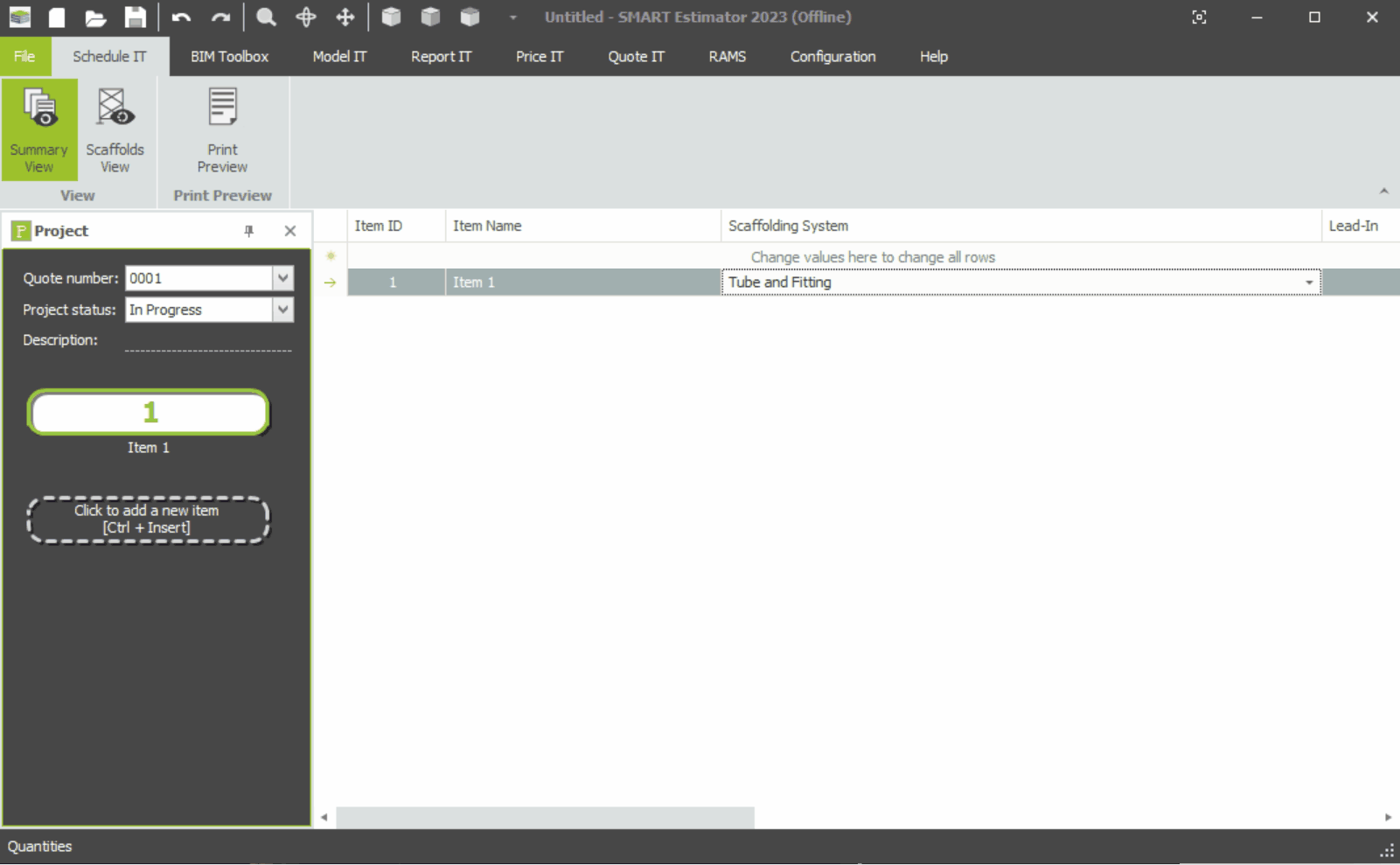
Alternately, you can change the scaffolding system within Model IT in the Tools view by clicking on the ‘Change Scaffolding System’ button and selecting the scaffolding system you wish to configure.
-
Select the Configuration Tool
Next we’ll need to open the Configuration module within SMART Estimator. Along the top toolbar, click on the ‘Configuration’ tab. This will open up the full list of components contained within the System Configuration.
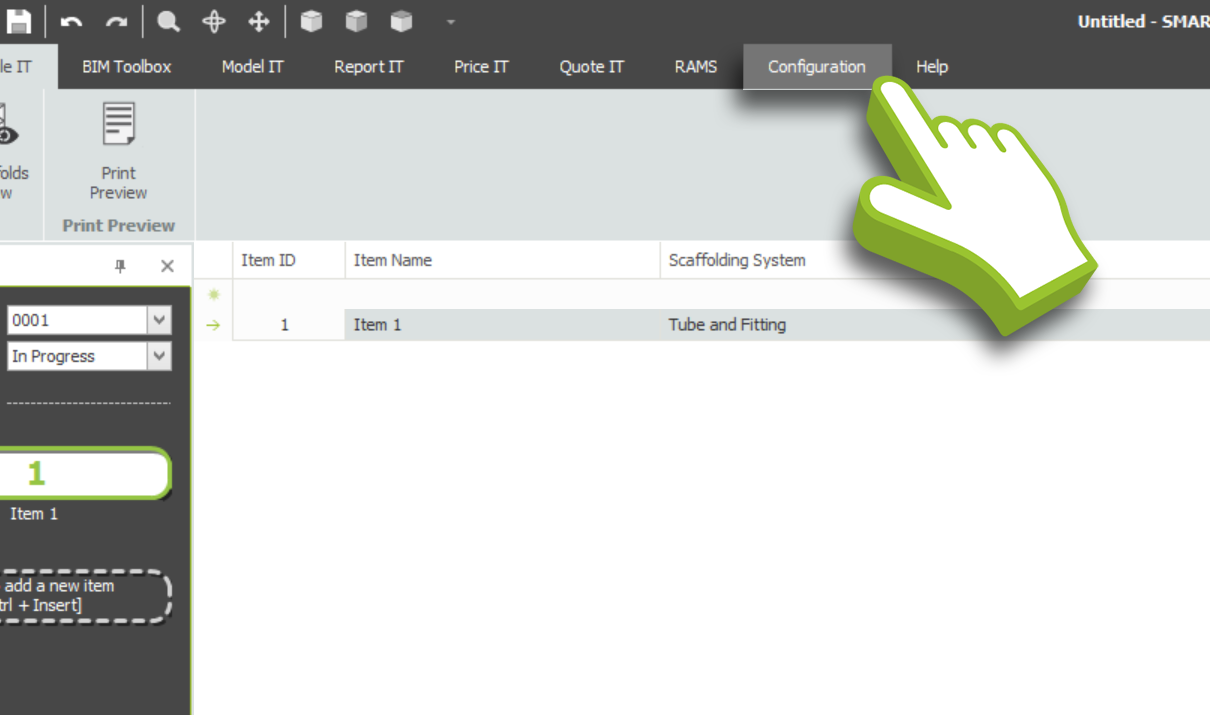
-
Configuring System Components: An Overview
You can choose between a couple of levels of configuration options here; all of your scaffold components are grouped according to the type of component, such as tubes, decking, beams, cladding, brackets and other bits and bobs, etc.
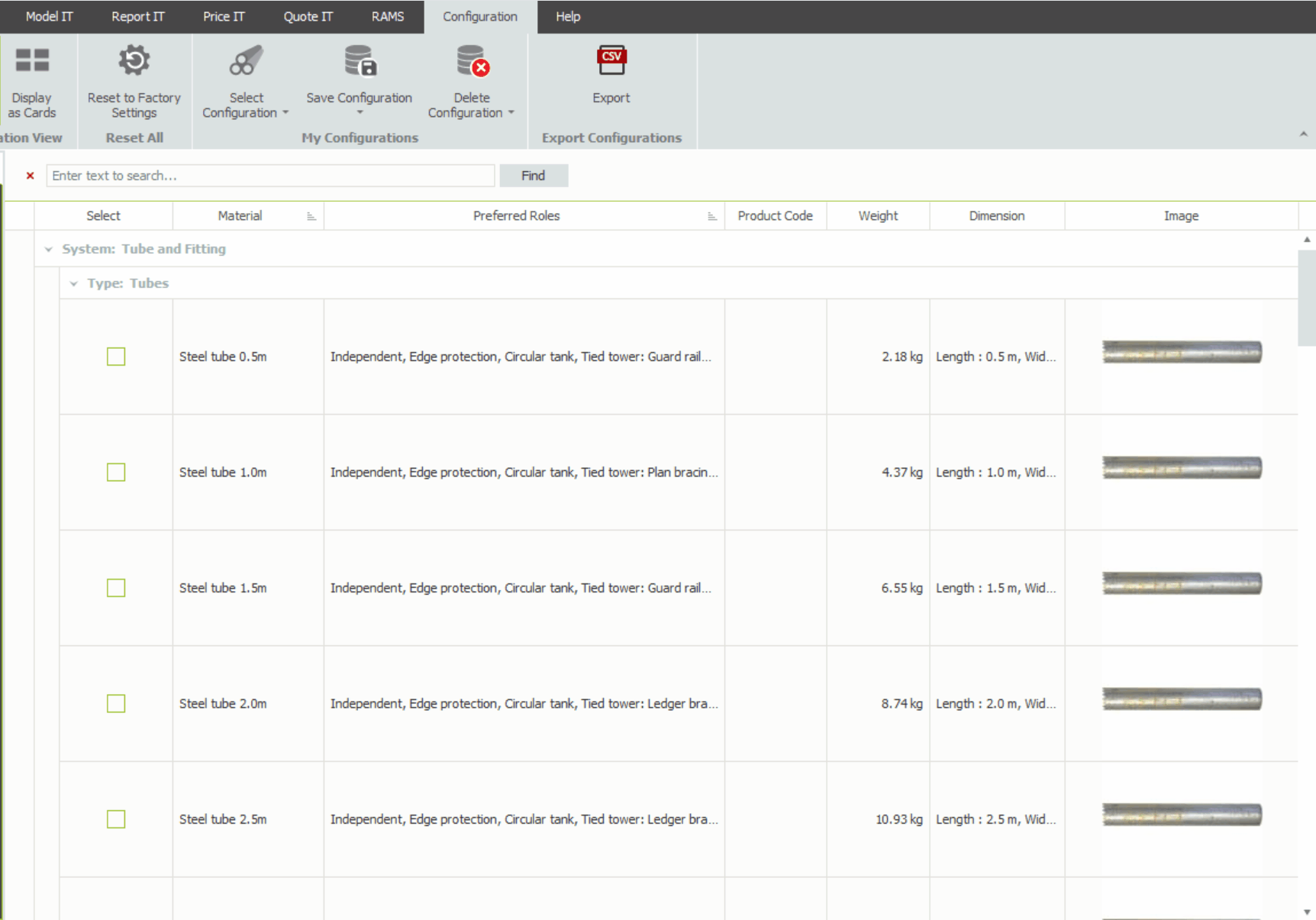
When configuring the Tube and Fitting scaffolding system, a few additional systems are included. Van Thiel and Readylok system scaffolds are included primarily for transoms, Haki is included primarily for stair towers, and Cuplok is also included for tube components.
The Haki and Cuplok systems are not configurable, since they are primarily used for stair towers, and they cannot be turned on or off. You can only set the price of the components involved in Stair Towers.
I’m not configuring the Tube and Fitting system!
In the case that you are using a System Scaffold, due to the prefabricated and modular nature of this scaffolding type. Your scaffolding system includes Tube and Fitting infill bays for the purpose of securely joining the system scaffold components together.
It is critical to note that these components are entirely separate from the ‘Tube and Fitting’ Scaffolding System; therefore, should you wish to use both ‘Tube and Fitting’ and your current configuration system for different scaffolding projects, both systems will need to be configured correctly.
-
Setting up the Prices for Components
Now we can begin configuring the pricing for your kits and components. Click on Show Pricing on the top left corner of the Ribbon. Five additional columns will now appear in the table.
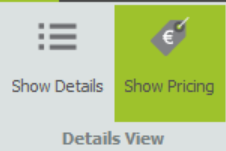
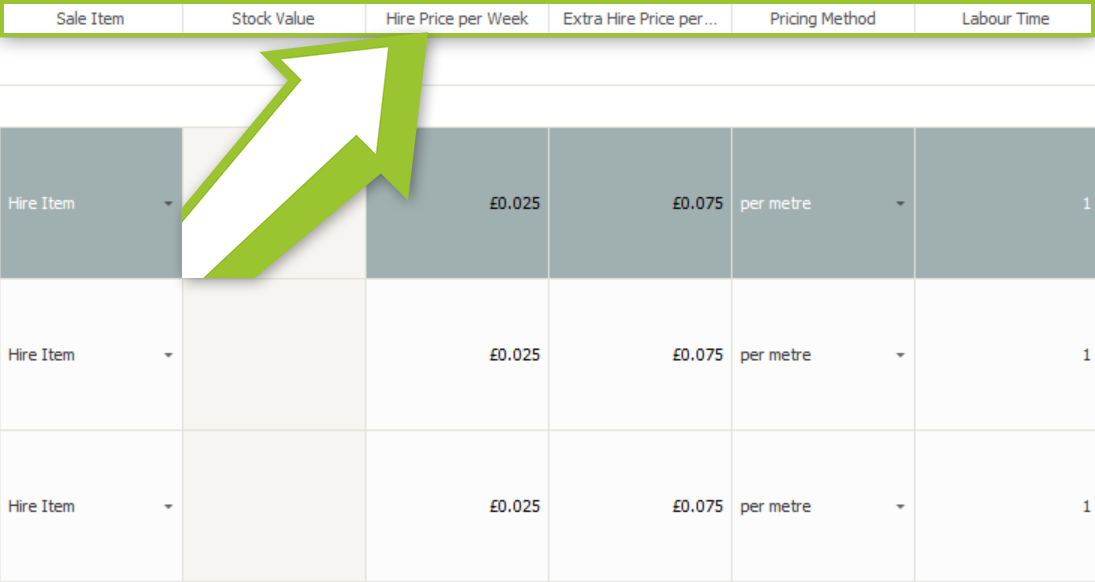
Clicking “Show Pricing” gives me an Error?
If you do not have permission to access the pricing view, when you click on the Show Pricing button, an error message will appear stating that you are not permitted to view the pricing view.
Please contact your IT team to obtain the necessary permissions.
- Sale Item
- Hire Item
Changing an item’s status between ‘hire’ or ‘sale’.
There are two ways of pricing your components within the SMART Estimator suite, under the ‘Sale Item’ column, you can choose whether a component is a “Hire Item” or a “Sale Item”.
There are some scaffolding components that cannot be returned in a condition suitable for use in the next scaffolding project (for example, non-reusable sale items such as corrugated sheets, debris netting, plastic sheeting, and safety tape). In this scenario, scaffolding components are usually sold rather than hired out.
Sale items will be displayed separately in Price IT and not included in Weekly Hire. As a result, they will have their own cost figure attributed to their price in the Cost Analysis.
If you are not selling the scaffold to your client, most components will be hire components. This means that a set weekly rate is charged throughout the duration of the hire period. At the end of the scaffolding project, all hire components will be returned to the yard for reuse in the future.
- Pricing the Sale Item’s Stock Value
- Pricing the Hire Item’s Labour price and Extra Hire
Pricing your components
In the next step, we will be configuring the prices between our Hire Items and Sale Items. This is done by entering the appropriate prices in their respective columns.
When adjusting the price for a Sale Item, you can set the Stock Value of an item. Stock values are used to determine the selling price of sale items, and they are unaffected by weekly hire prices and extra hire prices.
When adjusting the price of a Hire Item, you have the option of adding both a weekly hire price and an additional weekly extra hire price. This is your weekly material cost to hire out this component during the hire period, and the (usually larger) weekly charge after the hire period, respectively.
- per item
- per metre
- per foot
- per square metre
- per square foot
Configuring the pricing method for components
There are a variety of ways to set the price for a component, regardless of whether it is for hire or for sale. You can decide whether to set the price per foot, per metre, or per item.
This is the simplest pricing method. Whichever prices you have set are used for pricing the component.
The prices you have set are multiplied by the metric length of the component. You can use this to, for example, charge a rate based on the total length of all the tubes in the scaffold.
As per metre but measured in imperial feet.
The prices you set are multiplied by the metric area of the component. You can use this to, for example, charge a rate based on the total area of all the decking (boards) in the scaffold.
As per metre but measured in imperial square feet.
Using ‘per metre’ and ‘per foot’ measurements
When you use a pricing method other than the per item method, you will not see the multiplied rate for each individual component. However, the multiplied rate is used in Cost Analysis to price your scaffolding.
Calculating Labour Time
The Labour Time column in the scaffolding configuration is only used in Price IT to calculate the sum total of the Labour Time associated with each component of the scaffold to be erected and dismantled in component minutes.
In the labour time column, the erecting time is measured in minutes. Please enter the length of time required to erect the scaffolding component.
-
Repeat Step 5 for each component
Next, you will need to configure pricing for the list of scaffold components. For each scaffolding system you are using, ensure that the item status, the stock value, the weekly or extra hire rate, the pricing method, and the labour time are all configured correctly.
-
Saving your Configuration
After you have completed setting up your newly configured prices, click on ‘Save Configuration’ to save your changes. You can choose to overwrite an existing configuration or give it a new name to create an additional configuration. Thus, you can have multiple material rates for hire versus stock, different customers, or different types of work.
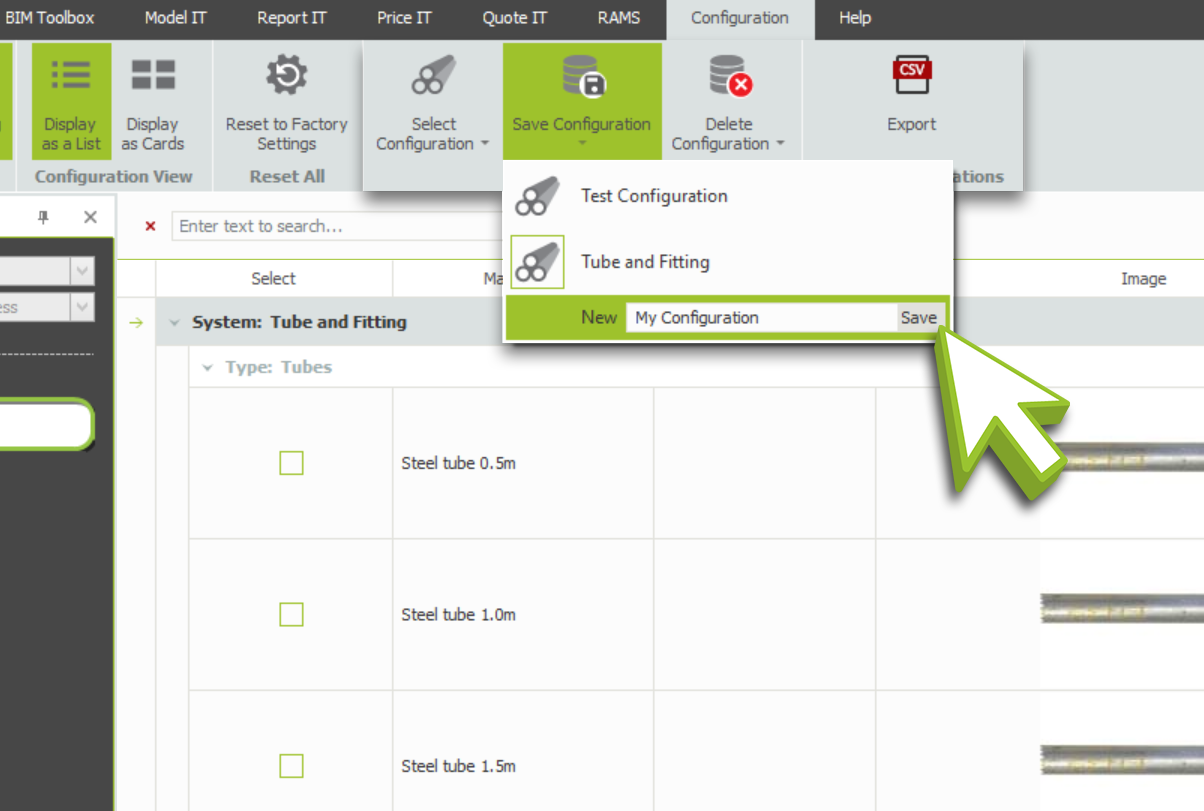
Renaming the Configuration
The display name of your configuration can be changed by selecting the ‘Select Configuration’ drop-down menu and then selecting ‘Set display name’. Here you can change how it’s displayed on the Quotation and on the ‘Change Scaffolding System’ buttons in Model IT Tools view, Report IT Material List and even the Schedule IT Summary View.
Deleting the Configuration
If you wish to remove a configuration you do not want, you can click on the ‘Delete Configuration’ drop-down menu. Then, select the configuration that you wish to permanently delete. As soon as you confirm that you wish to delete the configuration, it will be deleted and no longer accessible. Please take care not to delete a configuration by mistake, as this action cannot be reversed.
Exporting your Configuration
If you wish to review your prices or to share them as a spreadsheet, click the ‘Export Button’. A CSV file will be generated when the export button is clicked and confirmed. The CSV file contains all configurations and their prices. Thus, you can easily and quickly compare the prices of various configurations.
-
Your Configuration is Complete
As of this point, the configuration can be utilised within SMART Estimator. Once you’ve created a Project, you can choose the System Configuration by navigating to the Schedule IT Summary View. The System Configuration can also be selected in Model IT by clicking on the button Change Scaffolding System in the Tools View. You can also select the System Configuration option within Report IT by clicking on the same button.





